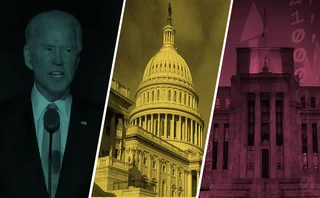
XVA calculation, backtesting and escape from Emir
The week on Risk.net, October 3-9, 2020

Danske quants discover speedier way to crunch XVAs
Differential machine learning produces results “thousands of times faster and with similar accuracy”
Broken backtests leave quant researchers at a loss
As historical data loses relevance, quants must find new ways to validate their theories
Escape from Emir? Not so fast, swaps users
Emir Refit, which seemed to promise reporting relief for corporate users, is not a master key
COMMENTARY: Not quite a quantum leap
Expensive, temperamental and able to handle only the simplest of problems – quantum computing hasn’t lived up to its promise so far. This week, Risk.net looked at the reasons why, and at some other areas where existing technology can be sharpened up to produce the kind of improvements quantum chips have so far failed to deliver.
The theoretical benefits of quantum computing have been known for years – a fully functioning quantum computer could have vastly greater processing speed, and allow breakthroughs in fields from cryptography to protein folding, not to mention financial modelling, in particular computationally demanding Monte Carlo simulations. But useful applications are waiting for a computer that can operate thousands of quantum bits (qubits) at once; at present systems that utilise a few dozen qubits is the best anyone seems to have managed.
This is frustrating – particularly right now, as backtesting becomes less useful in the face of unprecedented events, forcing analysts to rely more on simulations. It certainly would be useful to have a way of making those simulations cheaper and faster to run. But quantum computing remains, essentially, in the toy stage – impressively fast on small test portfolios, but still not capable enough to handle real-world cases.
Where one hyped technology fails, another – machine learning – may help fill the gap. This week, Risk.net also looked at Danske Bank’s successful route to faster credit valuation adjustments. It sidesteps the need for Monte Carlo simulations by feeding the results of an adjoint algorithmic differentiation – a list of sensitivities for various risk factors – into a neural network. Nested Monte Carlo simulations are the industry standard, but are punitively costly in machine time. And while a quantum computer could blaze through them in minutes, until a suitably functioning one comes along, a similar improvement can apparently be made using the Danske technique.
As a final point, this isn’t to dismiss the promise of quantum computing altogether. It’s not nuclear fusion, which is notoriously “the power source of the future, and always will be”. IBM’s plan for the future makes interesting reading. Its current best is a processor that handles 65 physical qubits (and it must be noted that translates into rather fewer ‘logical’ – or usable – qubits). But next year it is aiming for 127 physical qubits, 433 in 2022 and 1,121 by the end of 2023.
This early-stage exponential growth is more or less in line with Moore’s Law. And if it holds – as Moore’s Law did for many more decades than its inventor expected – the next few years will indeed be dull and uneventful in quantum computing. But they will be followed, in the late 2020s or early 2030s, by an explosion of revolutionary innovation. It is comforting, then, after a year of anxiously watching soaring case counts and death rates, to think that the human race might be on the right side of an exponential curve again.
STAT OF THE WEEK
On three days in the second quarter of 2020, the margin deposits held by the Fixed Income Clearing Corporation’s mortgage-backed securities division (MBSD) were judged insufficient to cover losses if two participants imploded. The unit estimated its peak stress loss to be $6.6 billion on one day between end-March and end-June, which was $887 million more than it had to hand – on two other days, estimated losses outmatched the default fund by $122 million and $50 million.
QUOTE OF THE WEEK
“My experience taught me a number of things. One, from a risk perspective we are all interconnected. Two, our collective memory is often short. Three, every crisis is a great corrector for market disorder and malpractice. Four, that the real outcome of such a correction, successful or not, depends upon us, the regulators: if we do not do our homework seriously and continuously, it will be a new beginning of another bad cycle” – Liu Mingkang, ex-CBRC
Further reading
Only users who have a paid subscription or are part of a corporate subscription are able to print or copy content.
To access these options, along with all other subscription benefits, please contact info@risk.net or view our subscription options here: http://subscriptions.risk.net/subscribe
You are currently unable to print this content. Please contact info@risk.net to find out more.
You are currently unable to copy this content. Please contact info@risk.net to find out more.
Copyright Infopro Digital Limited. All rights reserved.
You may share this content using our article tools. Printing this content is for the sole use of the Authorised User (named subscriber), as outlined in our terms and conditions - https://www.infopro-insight.com/terms-conditions/insight-subscriptions/
If you would like to purchase additional rights please email info@risk.net
Copyright Infopro Digital Limited. All rights reserved.
You may share this content using our article tools. Copying this content is for the sole use of the Authorised User (named subscriber), as outlined in our terms and conditions - https://www.infopro-insight.com/terms-conditions/insight-subscriptions/
If you would like to purchase additional rights please email info@risk.net
More on 7 days in 60 seconds
Bank capital, margining and the return of FX
The week on Risk.net, December 12–18
Hedge fund losses, CLS and a capital floor
The week on Risk.net, December 5–11
Capital buffers, contingent hedges and USD Libor
The week on Risk.net, November 28–December 4
SA-CCR, SOFR lending and model approval
The week on Risk.net, November 21-27, 2020
Fallbacks, Libor and the cultural risks of lockdown
The week on Risk.net, November 14-20, 2020
Climate risk, fixing Libor and tough times for US G-Sibs
The week on Risk.net, November 7-13, 2020
FVA pain, ethical hedging and a degraded copy of Trace
The week on Risk.net, October 31–November 6, 2020
Basis traders, prime brokers and election risk
The week on Risk.net, October 24-30, 2020
Most read
- Industry urges focus on initial margin instead of intraday VM
- For a growing number of banks, synthetics are the real deal
- Did Fed’s stress capital buffer blunt CCAR?







